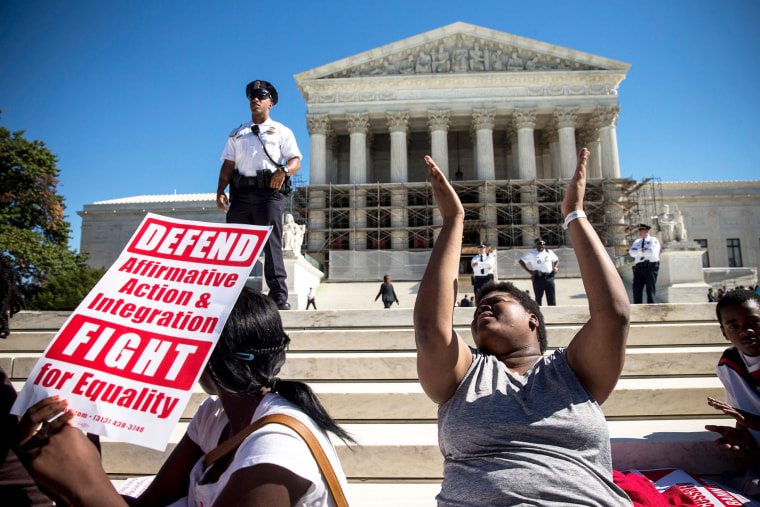A federal court upheld the University of Texas at Austin's admissions program Tuesday, a year after the U.S. Supreme Court punted on the issue of affirmative action and sent the case back to the lower courts for another look.
”We are persuaded that to deny UT Austin its limited use of race in its search for holistic diversity would hobble the richness of the educational experience," wrote Judge Patrick Higginbotham for a 2-1 majority on a panel of three judges from the U.S. Court of Appeals for the Fifth Circuit.
The decision sets up another potential showdown for affirmative action at the Supreme Court. The legality of considering race in college admissions has long seemed to hang by a thread, but last year the Supreme Court declined to overrule precedents upholding affirmative action and reached a 7-1 decision telling the lower courts to reconsider whether UT Austin's admissions policy was "narrowly tailored" enough to pass constitutional muster. Most of the admissions at UT Austin — about 80% each year — go to students in the top 10% of their graduating high school classes under the state's Top Ten Percent Plan. Although that plan has improved the diversity of Texas schools UT Austin instituted a "holistic review" process that considered race as one of multiple factors in filling the remaining spots, fearing that the Top Ten Percent process was too mechanical to properly evaluate the benefits an individual student could bring to the institution.
The lawsuit against UT Austin was brought by Abigail Fisher, a white student who claims the UT admissions process discriminated against her because she is white. Fisher applied to UT Austin in 2008 and was rejected. According to UT Austin, even if Fisher had received the maximum "personal achievement index" score under the holistic review process, she could not have been admitted. In other words, even if Fisher had been black or Hispanic, she could not have gained admission to the school. Fisher has since graduated from Louisiana State University, but she argues that UT Austin's consideration of race in admissions violated her constitutional rights regardless of whether or not she would have been admitted. Fisher's attorneys have said they will appeal the decision.
Civil rights groups praised Higginbotham's opinion. Sherrilyn Ifill, head of the the NAACP Legal Defense Fund, which has represented groups including the Black Student Alliance at UT Austin and Black Ex-Students of Texas, said the decision "should stand as a declaration of the ongoing importance and legality of affirmative action efforts that holistically evaluate applicants for admission in higher education."
Higginbotham's opinion does more than simply reaffirm the constitutionality of UT Austin's use of race as a factor in its holistic review process. In a detailed statistical analysis, the federal judge is highly critical of the Top Ten Percent Plan, which many opponents have held up as a workable race-neutral alternative to affirmative action. Higginbotham said it creates diversity largely because of ongoing racial segregation in Texas' schools.
"While the Top Ten Percent Plan boosts minority enrollment by skimming from the tops of Texas high schools, it does so against this backdrop of increasing resegregation in Texas public schools..."'
"The sad truth is that the Top Ten Percent Plan gains diversity from a fundamental weakness in the Texas secondary education system. The de facto segregation of schools in Texas enables the Top Ten Percent Plan to increase minorities in the mix, while ignoring contributions to diversity beyond race," Higginbotham wrote. "While the Top Ten Percent Plan boosts minority enrollment by skimming from the tops of Texas high schools, it does so against this backdrop of increasing resegregation in Texas public schools, where over half of Hispanic students and 40% of black students attend a school with 90%-100% minority enrollment."
Notably, UT Austin states that its admissions policy also benefits white students who attend those majority-minority schools but don't end up in the top 10% of their classes. The majority opinion states that the holistic review process, while adding minority students, largely benefited white students. According to the opinion, only 21% of the Hispanic students and 26% of black students were admitted through the holistic review process, compared to 35% of the incoming white students.
Critics of affirmative action have frequently described the approach as "racial quotas," but Higginbotham throws this accusation back at Fisher and her attorneys, stating that their insistence that Top Ten Percent is all that is needed to achieve diversity would affirm a de facto quota. "Fisher’s claim can proceed only if Texas must accept this weakness of the Top Ten Percent Plan and live with its inability to look beyond class rank and focus upon individuals," HiggInbotham wrote. "Perversely, to do so would put in place a quota system pretextually race neutral."
The opinion provoked a spirited dissent from Judge Emilio Garza, who wrote that the university "has not defined its diversity goal in any meaningful way" and so "it is altogether impossible to determine whether its use of racial classifications is narrowly tailored." Garza added that the majority’s sustained focus on the Top Ten Percent Law is misplaced," arguing that the law "matters only insofar as it causes the University to admit a large number of minority students separate and apart from the holistic review process."
This decision won't be the last word on the case, which could end up at the Supreme Court once again. The high court's refusal to kill affirmative action for good in 2013 should not be read as an endorsement. The Supreme Court could easily write an opinion outlining criteria for the use of race in college admissions so narrowly as to make it impossible. In the past, the court under Chief Justice John Roberts has displayed unanimity in reaching narrow decisions on controversial cases, only to reach broad rulings when the issue comes before the justices again. That could very well be their intent with affirmative action.
